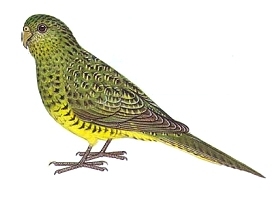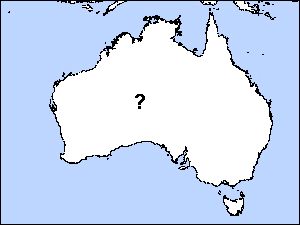Maybe-Extinct Parrot Search Gets £5,000
Posted by: Loren Coleman on March 15th, 2009

The (Australian) Night Parrot (Pezoporus occidentalis) is a small broad-tailed parrot endemic to the continent of Australia. The species was originally placed within its own genus (Geopsittacus), but most authors now prefer to place it within the genus Pezoporus together with the Ground Parrot.
The well-known budgerigar (called “parakeet” in America) is a not-too-distant relative of these birds.
The population size of this species is not known. Estimates range from extinct to not threatened at all. It is currently listed on the IUCN Red List as Critically Endangered.

There have been only a few reliable records of the bird since the 1880s, with the last authenticated report dating from 2006, when rangers found a dead specimen which had flown into a barbed wire fence in the Diamantina National Park in south western Queensland.

Prior to this, the last reliable sighting was of three individuals in 2005 near Minga Well, in the Pilbara region of Western Australia. Reliable sightings were made in 1990 when a roadkill specimen was discovered by scientists returning from an expedition in a remote part of Queensland and 1979 when a team of scientists from the South Australian Museum spotted an apparent flock of the birds in the far north of South Australia.
Ornithologists continue to patrol the outback for signs that the species still thrives, even checking the old nests of other birds, such as the Zebra Finch, for fragments of Night Parrot feathers. The Australian night parrot (Pezoporus occidentalis) remains one of the most elusive and mysterious birds in the world of ornithology.
New funding for a new search for this avian cryptid has been granted, according to a London-based article released when I was there.

The Australian night parrot: may or may not still exist
An amateur birdwatcher has been given £5,000 by a charity to go to Australia and hunt for a parrot – which is very likely to be extinct.
Andrew Parnell, a freelance writer, has been handed the cash to fund a six-week trip to the outback to find the Australian night parrot.
But examples of the species have been spotted just twice in the past ten years – and both times the bird was dead.
‘It’s very rare and classified as critically endangered,’ the 35-year-old said. ‘Very little is known about it and my chances of finding it are pretty slim.’ Mr Parnell, from Wymondham, Norfolk, became obsessed with the secretive bird (pictured) after reading about it in a book.
He applied for and won a Winston Churchill Travelling Fellowship to go to Australia to research its environment and talk to other experts.
The parrot was not seen at all between 1912 and 1979 and the last sighting was of a dead bird in 2006. Source: Joel Taylor, Metro
About Loren Coleman
Loren Coleman is one of the world’s leading cryptozoologists, some say “the” leading living cryptozoologist. Certainly, he is acknowledged as the current living American researcher and writer who has most popularized cryptozoology in the late 20th and early 21st centuries.
Starting his fieldwork and investigations in 1960, after traveling and trekking extensively in pursuit of cryptozoological mysteries, Coleman began writing to share his experiences in 1969. An honorary member of Ivan T. Sanderson’s Society for the Investigation of the Unexplained in the 1970s, Coleman has been bestowed with similar honorary memberships of the North Idaho College Cryptozoology Club in 1983, and in subsequent years, that of the British Columbia Scientific Cryptozoology Club, CryptoSafari International, and other international organizations. He was also a Life Member and Benefactor of the International Society of Cryptozoology (now-defunct).
Loren Coleman’s daily blog, as a member of the Cryptomundo Team, served as an ongoing avenue of communication for the ever-growing body of cryptozoo news from 2005 through 2013. He returned as an infrequent contributor beginning Halloween week of 2015.
Coleman is the founder in 2003, and current director of the International Cryptozoology Museum in Portland, Maine.










Its not like he’s searching for a the yowie or seomething its a parrot who cares if he don’t find it.
I very much care.
This is basic cryptozoology, the kind that happens all the time, although it does not get “celebrity cryptid headlines.”
This kind of cryptozoology, the research, searches for normal creatures, nothing wild or crazy, I believe helps to make cryptozoology a more legit science in other people’s eyes.
I believe that this kind of cryptozoology can make it a more legit science in other people’s eyes.
What are people going to fund and support more?
A search for yowie and bigfoot?
Or a search for a possibly extinct parrot?
Though I personally would prefer a few good Bigfoot expeditions.
This is extremely important; to cryptozoology, ornithology, and anyone who cares about animal life on the planet in general! Besides, a lot of cryptozoology isn’t proving whether or not the creature in question once roamed the earth, but rather whether or not the creature has reached the point of extinction. Thank you for the post Loren.
I lived in Karratha in the Pilbara for five years and that area is so vast and uninhabited that a small pocket of these birds could be undisturbed for centuries, a bird that has a burrow and is nocturnal would be extremely difficult to find in that region. I have been a reader for years now and would like to say thanks for all the interesting articles relating to australian fauna.